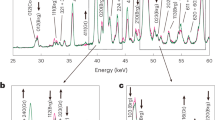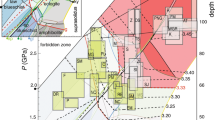Abstract
Oceanic lithosphere sinks into Earth’s mantle at subduction zones. However, seismic tomography shows that the sinking slabs of lithosphere often stagnate in the lower part of the mantle transition zone1, at depths less than 660 km, where rocks undergo pressure-induced phase transitions and become denser. Greater pressures are required to induce phase transitions in cold slabs compared with the hotter ambient mantle at the 660 km discontinuity, and so, at the boundary between the transition zone and the lower mantle, the slabs are buoyant2. The slabs may also contain low-density minerals that could contribute to their buoyancy3. Here we use laboratory experiments to analyse the rate of dissolution of the common slab mineral pyroxene into garnet, at pressures and temperatures representative of the lower part of the mantle transition zone. We find that the majorite component in garnet—a product of the transition from pyroxene into garnet—is one of the slowest-diffusing components in Earth’s mantle. At the relatively low temperatures of the slab, this slow diffusion inhibits the dissolution of pyroxene into garnet, so that the slab remains buoyant relative to the ambient mantle and stagnates. However, at the base of the mantle transition zone, pyroxene undergoes another phase transformation to the mineral akimotoite, which causes a sudden increase in slab density. We conclude that the slab is likely to penetrate into the lower mantle eventually.
This is a preview of subscription content, access via your institution
Access options
Subscribe to this journal
Receive 12 print issues and online access
$259.00 per year
only $21.58 per issue
Buy this article
- Purchase on Springer Link
- Instant access to full article PDF
Prices may be subject to local taxes which are calculated during checkout




Similar content being viewed by others
References
Kárason, H. & Van der Hilst, R. D. in The History and Dynamics of Global Plate Motion Vol. 121 (eds Richards, M. R., Gordon, R. & Van der Hilst, R. D.) 277–288 (American Geophysical Union, 2000).
Fukao, Y., Obayashi, M. & Nakakuki, T. Stagnant slab: A review. Annu. Rev. Earth Planet. Sci. 37, 19–46 (2009).
Tetzlaff, M. & Schmeling, H. The influence of olivine metastability on deep subduction of oceanic lithosphere. Phys. Earth. Planet. Inter. 120, 29–38 (2000).
Bass, J. D. & Parise, J. B. Deep earth and recent developments in mineral physics. Elements 4, 157–165 (2008).
Frost, D. J. The upper mantle and transition zone. Elements 4, 171–176 (2008).
Irifune, T., Sekine, T., Ringwood, A. E. & Hibberson, W. O. The eclogite–garnetite transformation at high pressure and some geophysical implications. Earth. Planet. Sci. Lett. 77, 245–256 (1986).
Ganguly, J., Freed, A. M. & Saxena, S. K. Density profiles of oceanic slabs and surrounding mantle: Integrated thermodynamic and thermal modelling, and implications for the fate of slabs at the 660 km discontinuity. Phys. Earth. Planet. Inter. 172, 257–267 (2009).
Nishi, M., Kato, T., Kubo, T. & Kikegawa, T. Survival of pyropic garnet in subducting plates. Phys. Earth. Planet. Inter. 170, 274–280 (2008).
Nishi, M., Kubo, T. & Kato, T. Metastable transformations of eclogite to garnetite in subducting oceanic crust. J. Mineral. Petrol. Sci. 104, 192–198 (2009).
Chakraborty, S. & Ganguly, J. Cation diffusion in aluminosilicate garnets: Experimental determination in spessartine-almandine diffusion couples, evaluation of effective binary diffusion coefficients, and applications. Contrib. Mineral. Petrol. 111, 74–86 (1992).
Holzapfel, C., Chakraborty, S., Rubie, D. C. & Frost, D. J. Fe–Mg interdiffusion in wadsleyite: The role of pressure, temperature and composition and the magnitude of jump in diffusion rates at the 410 km discontinuity. Phys. Earth. Planet. Inter. 172, 28–33 (2009).
Chakraborty, S. Diffusion coefficients in olivine, wadsleyite and ringwoodite. Rev. Mineral. Geoch. 72, 603–639 (2010).
Shimojuku, A. et al. Si and O diffusion in (Mg,Fe)2SiO4 wadsleyite and ringwoodite and its implications for the rheology of the mantle transition zone. Earth. Planet. Sci. Lett. 284, 103–112 (2009).
Holzapfel, C., Rubie, D. C., Frost, D. J. & Langenhorst, F. Fe-Mg interdiffusion in (Mg,Fe)SiO3 perovskite and lower mantle reequilibration. Science 309, 1707–1710 (2005).
Crank, J. The Mathematics of Diffusion (Oxford Univ. Press, 1980).
McKenzie, D. & Bickle, M. J. The volume and composition of melt generated by extension of the lithosphere. J. Petrol. 29, 625–679 (1988).
Anderson, D. L. The thermal state of the upper mantle; No role for mantle plumes. Geophys. Res. Lett. 27, 3623–3626 (2000).
Katsura, T., Yoneda, A., Yamazaki, D., Yoshino, T. & Ito, E. Adiabatic temperature profile in the mantle. Phys. Earth. Planet. Inter. 183, 212–218 (2010).
Akaogi, M. & Akimoto, S. High-pressure phase equilibria in a garnet lherzolite, with special reference to Mg2+–Fe2+ partitioning among constituent minerals. Phys. Earth Planet. Inter. 19, 31–51 (1979).
Rubie, D. C. & Thompson, A. B. in Metamorphic Reactions: Kinetics, Textures and Deformation Vol. 4 (eds Thompson, A. B. & Rubie, D. C.) 27–79 (Springer, 1985).
Robinson, P. et al. Tectono-stratigraphic Setting, Structure and Petrology of HP and UHP Metamorphic Rocks and Garnet Peridotites in the Western Gneiss Region, More and Romsdal, Norway 142 (NGU, 2003).
Emmerson, B. & McKenzie, D. Thermal structure and seismicity of subducting lithosphere. Phys. Earth. Planet. Inter. 163, 191–208 (2007).
Akaogi, M. & Akimoto, S. Pyroxene-garnet solid–solution equilibria in the systems Mg4Si4O12–Mg3Al2Si3O12 and Fe4Si4O12–Fe3Al2Si3O12 at high pressures and temperatures. Phys. Earth. Planet. Inter. 15, 90–106 (1977).
Turcotte, D. L. & Schubert, G. Geodynamics (Cambridge Univ. Press, 2002).
Song, S., Zhang, L. & Niu, Y. Ultra-deep origin of garnet peridotite from the North Qaidam ultrahigh-pressure belt, Northern Tibetan Plateau, NW China. Am. Mineral. 89, 1330–1336 (2004).
Hogrefe, A., Rubie, D. C., Sharp, T. G. & Seifert, F. Metastability of enstatite in deep subducting lithosphere. Nature 372, 351–353 (1994).
Shiraishi, R., Ohtani, E., Kanagawa, K., Shimojuku, A. & Zhao, D. Crystallographic preferred orientation of akimotoite and seismic anisotropy of Tonga slab. Nature 455, 657–660 (2008).
Ganguly, J., Cheng, W. & Chakraborty, S. Cation diffusion in aluminosilicate garnets: Experimental determination in pyrope-almandine diffusion couples. Contrib. Mineral. Petrol. 131, 171–180 (1998).
Gasparik, T. Phase Diagrams for Geoscientists: An Atlas of the Earth’s Interior (Springer, 2003).
Acknowledgements
Funding of this project is provided by the European Commission through the Marie Curie Research Training Network ‘c2c’ (Contract No. MRTN-CT-2,006-035957) and the Leibniz programme of the Deutsche Forschungsgemeinschaft (LA 830/14-1).
Author information
Authors and Affiliations
Contributions
All authors contributed in writing the paper. F.L. and W.L.v.M. conceived the idea for the experiments. F.L. supervised the project. D.J.F. and D.C.R. provided further advice for developing the experimental strategy. W.L.v.M. performed the experiments, conducted the TEM measurements and carried out the data reduction. Numerical modelling was performed by W.L.v.M.
Corresponding author
Ethics declarations
Competing interests
The authors declare no competing financial interests.
Supplementary information
Supplementary Information
Supplementary Information (PDF 650 kb)
Rights and permissions
About this article
Cite this article
van Mierlo, W., Langenhorst, F., Frost, D. et al. Stagnation of subducting slabs in the transition zone due to slow diffusion in majoritic garnet. Nature Geosci 6, 400–403 (2013). https://doi.org/10.1038/ngeo1772
Received:
Accepted:
Published:
Issue Date:
DOI: https://doi.org/10.1038/ngeo1772
This article is cited by
-
Contact of the Samoan Plume with the Tonga Subduction from Intermediate and Deep-Focus Earthquakes
Surveys in Geophysics (2021)
-
Polymorphism of feldspars above 10 GPa
Nature Communications (2020)
-
Garnet, the archetypal cubic mineral, grows tetragonal
Scientific Reports (2019)
-
Compressional behavior of end-member and aluminous iron-bearing diopside at high pressure from single-crystal X-ray diffraction and first principles calculations
Physics and Chemistry of Minerals (2019)
-
Diffusion in garnet: a review
Acta Geochimica (2018)



